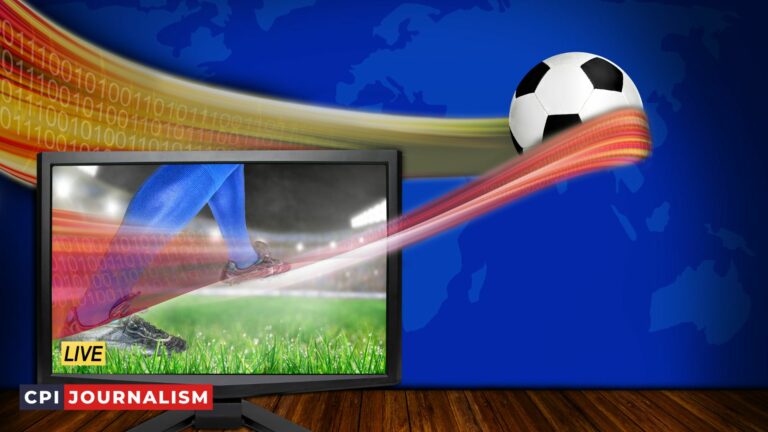How Can Sports Journalists Use Live Streaming To Enhance Their Coverage Of Events?
As an experienced sports journalist, I understand the importance of providing comprehensive and timely coverage of sporting events to keep viewers informed and engaged.
In recent years, live streaming has become a vital tool for sports journalists to enhance their coverage, as it allows us to bring viewers closer to the action than ever before.
In this article, I will explore how sports journalists can use live streaming to maximize their coverage of events and provide viewers with an immersive experience that they simply can’t get anywhere else.
A. Benefits Of Live Streaming For Sports Journalists
Live streaming can be an invaluable tool for sports journalists who are looking to provide comprehensive coverage of events.
Not only does live streaming enable sports journalists to broadcast events from anywhere in the world, but it can also provide a unique perspective on the action that viewers won’t be able to get anywhere else.
Here are some of the key benefits of live streaming for sports journalists.
1. Immediacy: Live streaming allows sports journalists to instantly share their coverage of events with viewers around the world.
This means viewers can stay up-to-date with the latest developments as they happen, rather than waiting for updates in the days or weeks after the event takes place. This immediacy can be especially valuable in sports journalism, where news can quickly become outdated.
2. Accessibility: Many sports events can be difficult to access in person due to location and cost. However, live streaming allows sports journalists to provide coverage of these events without having to be physically present.
This means more viewers can access the content, leading to a larger potential audience for the journalist’s work.
3. Engagement: Live streaming provides an opportunity for sports journalists to directly interact with viewers during events.
This enables journalists to answer questions and provide commentary in real-time, creating a more engaging experience for viewers. This can be especially useful for breaking news, as it allows viewers to ask questions and get answers quickly.
4. Reach: Live streaming allows sports journalists to reach a much larger audience than what would be possible with traditional media.
This is because live streaming can be broadcast to anyone with an internet connection, regardless of their location or device. This means sports journalists can reach a truly global audience with their coverage.
Using live streaming, sports journalists can provide comprehensive coverage of events, while also reaching a much larger audience than what would be possible with traditional media. Live streaming can also provide a unique perspective on the action that viewers won’t be able to get anywhere else.
By taking advantage of the benefits of live streaming, sports journalists can enhance their coverage of events and reach a much wider audience.
II. Benefits Of Live Streaming For Sports Journalists
Live streaming offers sports journalists a number of benefits that can help them enhance their coverage of events. With live streaming, journalists can provide their audiences with real-time updates and on-the-ground perspectives that would otherwise be difficult to obtain.
Additionally, live streaming can help to increase the reach of a journalist’s coverage, as it provides viewers around the world with access to an event in real-time.
Live streaming also has the potential to reach a broader audience than traditional broadcast outlets, as it requires no subscription or payment. This can help to increase the visibility of a journalist’s work, allowing them to reach more people and potentially attract new readers or viewers.
Finally, live streaming can help to save time and money for sports journalists. Live streaming provides journalists with the ability to cover events from anywhere, eliminating the need for costly travel expenses.
Additionally, it can be more time-efficient than traditional broadcast outlets, allowing journalists to cover events in real-time without having to wait for post-event editing and production.
Overall, live streaming provides sports journalists with a number of benefits that can help them enhance their coverage of events. Live streaming can provide real-time updates and on-the-ground perspectives, increase their coverage’s reach, and save time and money.
As such, it is an invaluable tool for sports journalists and should be considered when covering events.
A. Increased Reach
Live streaming is a powerful tool for sports journalists looking to extend the reach of their coverage of events. With live streaming, journalists can reach audiences around the world, giving them access to events they may not have been able to attend in person.
Live streaming also gives journalists the opportunity to engage with their audience in real time. This can be done by providing audience members with the chance to ask questions during the broadcast, or by allowing them to discuss the event as it is happening.
This can help to create a more immersive experience and can help to build a loyal audience of viewers who will come back to the channel time and time again.
In addition, live streaming allows journalists to create content that can be shared on social media. This can help to further increase the reach of the coverage, and can help to generate additional interest in the event.
By creating content that is engaging and informative, journalists can draw in audiences from all over the world.
Live streaming is a powerful tool for sports journalists looking to extend the reach of their coverage and engage with their audience. With the right content and strategy, journalists can use live streaming to create a truly global audience for their coverage.
B. Improved Engagement
Live streaming, when done correctly, can be an invaluable tool for sports journalists. It allows for improved engagement with viewers and increases the reach of the coverage.
This enhanced engagement can be achieved in several ways, including the following:
1. Increasing Interactivity: Live streaming gives viewers the chance to interact with the reporter in real-time. This allows for questions to be answered, stories to be shared, and discussions to be had in a way that would not be possible with traditional television broadcasts.
2. Offering Multiple Perspectives: Live streaming also allows for multiple perspectives to be shared in a single broadcast.
This can be done by having multiple cameras in different locations and allowing viewers to switch between them, or by broadcasting multiple commentators in different locations.
3. Engaging Through Social Media: Live streaming can also be used in combination with social media to further engage viewers.
This can be done by allowing viewers to post questions or comments on the broadcast page, or by engaging with viewers through social media channels such as Twitter and Facebook.
These are just a few of the many ways in which sports journalists can use live streaming to enhance their coverage of events.
By engaging with viewers in real-time, offering multiple perspectives, and leveraging social media, sports journalists can significantly increase the reach and impact of their coverage.
C. Increased Accessibility
Live streaming is a great way for sports journalists to reach more people with their coverage of events. Live streaming makes it easier for fans to access content from their own homes, no matter where in the world they are located.
This means that more fans can be reached with the same message, making sports journalism more accessible and more inclusive of a broader range of viewers.
Additionally, live streaming can be used to provide more detailed coverage of events. Instead of just a few snippets of the game, viewers can get a more comprehensive look at the event, including interviews, highlights, and more.
This allows viewers to gain a better understanding of the event and its participants, leading to a more thorough and engaging experience.
Live streaming also allows journalists to cover events that might otherwise be too far away or difficult to access. Journalists can now cover events in remote locations, giving viewers a chance to experience something they might not have had the opportunity to before.
In addition, live streaming can be used to cover multiple events at once, or even to cover events that are happening simultaneously. This means that viewers can stay up to date on multiple events at once, without having to miss out on anything.
Overall, live streaming technology is a great way for sports journalists to reach more people and provide more comprehensive coverage of events. Live streaming allows viewers to experience events in real time, and gives them a more comprehensive understanding of the event.
It also allows journalists to cover events that would otherwise be difficult to access. With live streaming, sports journalists can provide a more comprehensive and engaging experience for viewers, no matter where in the world they are located.
D. Ability To Reach a Wider Audience
Live streaming is a great way for sports journalists to reach a wider audience. Live streaming provides an opportunity to reach people who are unable to attend the event in person, allowing them to still be part of the action.
Live streaming also allows for a greater level of interaction between the journalist and the audience. This can be done through live chat, allowing the journalist to get real-time feedback from the audience and create a more engaging experience for the viewers.
Live streaming also provides the opportunity to increase the reach of the coverage by making it available on various platforms.
Live streaming platforms such as YouTube Live and Facebook Live allow the journalist to broadcast their coverage to a larger audience, as well as enabling them to connect with viewers from all over the world. This can be especially beneficial for journalists covering international events.
Live streaming also provides journalists with the opportunity to monetize their coverage. By partnering with a platform such as YouTube, journalists can monetize their live streams and earn revenue from their coverage. This can be a great way for journalists to supplement their income and grow their audience.
Overall, live streaming provides a great opportunity for sports journalists to increase their reach, engage with their audience and monetize their content. Live streaming can be a great way to enhance the coverage of events and make the experience more interactive and engaging for the viewers.
III. Challenges of Live Streaming for Sports Journalists
Live streaming sports events comes with a variety of challenges that can make it difficult for sports journalists to properly cover an event.

Some of the biggest challenges of live streaming for sports journalists include:
1. Technical Issues: Live streaming can be a technical challenge, and sports journalists must be prepared to troubleshoot any technical issues that arise during an event. This can include problems with the stream itself, or with the equipment used to record the stream.
2. Accessibility: Sports journalists must also consider the accessibility of the stream. Many live streams are only accessible in certain countries or regions, which can limit the audience that can watch the stream.
Additionally, some live streams require a subscription or payment to access, which can make it difficult for a journalist to share the stream with their audience.
3. Cost: Live streaming can also be costly, and sports journalists must consider the cost of the stream when deciding whether or not to cover an event. Many streams require a subscription fee, and some may also require additional equipment or services to be able to stream an event.
4. Quality: Finally, sports journalists must consider the quality of the stream when deciding whether or not to cover an event. Poor quality streams can make it difficult for viewers to understand the action on the field and can make the coverage less engaging.
These are just a few of the challenges that sports journalists must consider when deciding whether or not to cover an event via live streaming.
With the right preparation and understanding of the challenges, however, sports journalists can use live streaming to enhance their coverage of sports events.
A. Technical Issues
Live streaming is a great way for sports journalists to enhance their coverage of events. However, it also presents unique technical challenges.
Before beginning to live stream, journalists should be aware of the following technical issues:
1. Bandwidth: Live streaming requires a reliable internet connection with enough bandwidth to stream the event without interruption. Many venues provide free Wi-Fi, but journalists should make sure they have the necessary bandwidth to stream in high-quality.
2. Equipment: Journalists should make sure they have the proper equipment for streaming. This includes cameras, microphones, tripods, and any other necessary equipment.
3. Software: Journalists need to make sure they have the right software for streaming. This includes streaming programs, video editing software, and any other necessary software.
4. Experience: Live streaming can be difficult for inexperienced journalists. Journalists should make sure they have the necessary experience and knowledge to stream events without any technical issues.
By being aware of these technical issues and taking the necessary steps to ensure a smooth live stream, sports journalists can confidently use live streaming to enhance their coverage of events.
B. Cost
Live streaming events can be an expensive endeavor for sports journalists. Depending on the type of equipment and software needed, the cost can range from a few hundred dollars to thousands.
In addition to the cost of the equipment, there may be fees associated with streaming services, such as bandwidth and hosting fees. There may also be costs associated with setting up the event, such as paying for a venue, security, and other personnel.
For journalists on a budget, there are more cost-effective options. Free streaming services, such as Facebook Live and YouTube Live, are available for those who wish to stream their events for free. However, these services may not offer the best quality or the most reliable connection.
For more professional coverage, journalists may want to look into paid streaming services. These services typically offer higher quality streaming, more reliable connections, and additional features, such as analytics and archiving. However, they can also be significantly more expensive.
Ultimately, the cost of live streaming will depend on the type of coverage a journalist wishes to provide. Journalists should carefully consider their budget and the type of coverage they need before committing to a streaming service.
C. Copyright Issues
When it comes to streaming events live, copyright issues should be a primary concern for sports journalists. Before streaming an event, make sure you have the rights to do so.
Many sports organizations have agreements with broadcast companies that prohibit journalists from live streaming an event.
This is especially true for sports matches that are broadcast on TV or radio. It’s important to check with the organization or governing body that is responsible for the event to make sure that you have the necessary clearance to stream it live.
In addition to obtaining the necessary rights to live stream an event, it’s important to ensure that you are not violating any copyright laws. If you are streaming music or showing film clips as part of your live coverage, make sure you have the rights to do so.
This includes obtaining the necessary licenses to use any copyrighted material. Failure to do so could result in legal action being taken against you.
Finally, make sure you are aware of any rules or regulations that may be in place regarding live streaming and sports coverage. These rules and regulations may vary depending on the governing body or organization that is responsible for the event.
It’s important to be familiar with the rules and regulations to make sure that you are following them when streaming an event.
By following these guidelines, sports journalists can ensure that they are able to live stream events without running into any copyright issues. This will allow them to enhance their coverage of events and provide viewers with a unique and exciting experience.
D. Lack Of Resources
Live streaming technology is a powerful tool for sports journalists, but unfortunately, there are many challenges associated with it. One of the most significant obstacles is a lack of resources. Many journalists lack the necessary equipment and software to effectively stream an event.
For instance, in order to stream a professional sports game, a journalist must have access to a high-quality camera, a powerful computer, and the right software. The cost of these items can be prohibitive for smaller news organizations or individual journalists.
Similarly, streaming an event in a remote location often requires a good internet connection, which is not always available.
Moreover, even if a journalist has the necessary equipment and software, they may still struggle to effectively live stream an event. For example, they may lack the technical expertise to configure the system correctly, or they may not be familiar with the necessary streaming protocols.
In order to overcome these challenges, journalists need to invest in high-quality equipment and software and become knowledgeable about streaming protocols.
Additionally, they should consider collaborating with other journalists or news organizations in order to pool resources. Finally, they can take advantage of free trials or demos to gain hands-on experience with live streaming technology.
IV. Strategies for Successful Live Streaming
Live streaming can be a powerful tool for sports journalists to enhance their coverage of events. However, it requires a strategic approach to ensure success.
Here are some key strategies to consider when live streaming an event:
1. Plan Ahead: Make sure you have a clear plan for how you will cover the event. This includes determining the type of material you will stream and how long you will stream for.
It is also important to consider the technical requirements for streaming, such as the hardware and software needed.
2. Utilize Social Media: Leverage social media to increase the reach of your live stream. Use platforms such as Twitter and Facebook to share the link to your stream and to engage with viewers.
3. Engage With Viewers: Make sure to engage with viewers throughout the stream. Ask questions and solicit feedback to keep viewers engaged and to create a more interactive experience.
4. Monitor the Stream: Monitor the stream throughout to ensure the quality of the stream remains high. This includes troubleshooting any technical issues that may arise.
5. Post-Stream Analysis: After the stream is complete, review the performance of the stream. This includes analyzing the analytics to determine the reach of the stream and gathering feedback from viewers.
By following these strategies, sports journalists can ensure that their live streams are successful and engaging. Following a strategic approach will also help to maximize the reach and engagement of the stream.
A. Invest in Quality Equipment
As a sports journalist, investing in quality equipment should be your number one priority. Good quality equipment will allow you to capture the best possible footage, and produce high-quality live streams of events.
A good setup should include a high-quality camera, an audio recorder, and a laptop or computer to process the footage.
It is also important to invest in good lighting equipment. This will ensure that you get the best possible video quality. You may also want to invest in other equipment such as a microphone, tripods, and stabilizers.
Finally, don’t forget about software. Investing in good video editing software will help you to produce professional-looking live streams. Make sure that you are familiar with how to use the software, so that you can quickly and effectively edit your footage.
By investing in quality equipment, you will be able to produce high-quality live streams of events, and ensure that your coverage is of the highest standard possible.
B. Utilize Social Media Platforms
Social media platforms are a powerful tool for sports journalists to effectively reach their audience and engage them in their coverage of the event.
Journalists can use social media platforms like Twitter, Facebook, Instagram, and YouTube to post updates, commentaries, and highlights of the event in real-time, allowing the audience to stay up-to-date with the latest developments and engage with their coverage.
Twitter is especially suitable for live coverage of events, as it allows journalists to quickly and easily share updates, photos, and videos in real time with their followers. Journalists can also join in conversations, answer questions, and engage with their audience in real time.
They can also use Twitter to interact with other sports journalists and commentators, allowing them to gain insights and perspectives on the event.

Facebook and Instagram are also great tools for sports journalists, allowing them to post updates, photos, and videos of the event in real time.
Journalists can also interact with their fans and followers on these platforms, allowing them to engage with their audience in a more personal way.
On Instagram, in particular, journalists can share behind-the-scenes photos and videos of the event to give their audience a more intimate look into what is happening.
Finally, YouTube can be used to post live coverage of the event, as well as highlight reels and post-game commentary. Journalists can also use YouTube to post interviews with athletes and coaches, giving their audience a more in-depth look into the event.
Overall, social media platforms are a great tool for sports journalists to effectively reach and engage their audience in their coverage of the event.
With the right strategy and content, journalists can create an engaging and informative experience for their audience and make their coverage of the event even more impactful.
C. Develop a Content Strategy
As a sports journalist, you should consider developing a content strategy that is tailored to live streaming coverage of events. This content strategy should include both short-term and long-term goals.
In the short-term, you should focus on creating content that is engaging and relevant to the event you are covering. This could include pre-event interviews with athletes, post-event wrap-up videos and live streaming of the event itself.
For long-term goals, you should look at ways to leverage the live streaming technology to create content that will continue to engage your audience after the event is over.
This could include creating highlight videos and other content that can be shared across social media platforms.
You should also look into ways to monetize your live streaming content, such as offering sponsored content or subscription services.
Finally, you should also pay attention to the analytics of your live streaming content. This will allow you to track how engaging your content is, and make adjustments to your content strategy as needed.
With the right content strategy, you can use live streaming to maximize your coverage of events and engage your audience.
D. Utilize Live Streaming Platforms
Live streaming platforms are a great way for sports journalists to enhance their coverage of events. Live streaming allows journalists to provide viewers with real-time, up-to-the-minute coverage of the event, providing an immersive experience that on-location reporting simply can’t match.
For sports journalists, the key to successful live streaming is to make sure that the audio and video quality is top-notch. Good audio and video quality will help ensure that viewers stay engaged and keep watching.
Investing in high-quality equipment is a must for anyone looking to live stream sporting events.
In addition to the audio and video quality, sports journalists should also focus on providing viewers with additional content. This could include providing viewers with insider information, statistics, or interviews with players and coaches.
Offering viewers additional content will help keep them engaged and provide viewers with a more comprehensive understanding of the event.
Finally, sports journalists should also make sure that they are using the right live streaming platform.
Different platforms offer different features, and some may be better suited for certain types of events than others. Make sure to do your research and find the platform that best suits your needs.
Live streaming is a great way for sports journalists to provide viewers with real-time coverage of events. With the right equipment, additional content, and the right platform, sports journalists can provide viewers with a comprehensive and immersive experience that will keep them coming back for more.
V. Conclusion
Live streaming can be an invaluable tool for sports journalists to enhance their coverage of events. It enables them to provide an immersive experience for viewers, allowing them to feel like they are right there in the action.
With the right technology and strategies, live streaming can help journalists reach a wider audience, engage viewers with interactive content, and create a more dynamic viewing experience.
Live streaming can also help journalists to build their credibility and reputation in the industry. By providing quality content that is easy to access and engage with, journalists can gain the trust of viewers and become known for their work.
With the rise of digital media, live streaming is an effective way for journalists to stay up-to-date and reach a larger audience.
Overall, live streaming is an invaluable tool for sports journalists to use in their coverage of events. With the right strategies and technology, it can be a great way to reach a wider audience, engage viewers, and create a more dynamic viewing experience.
Live streaming can help journalists to build credibility and reputation in the industry, as well as stay up-to-date and relevant with the changing media landscape.
A. Summary of Benefits and Challenges
Live streaming provides an immense opportunity for sports journalists to enhance their coverage of events. The benefits of live streaming are numerous, including being able to reach a larger audience, create more engaging content, and to provide more comprehensive coverage.
Live streaming can also provide journalists with a more immediate platform to share their stories and give viewers an up-close and personal experience of the event.
However, there are also some challenges associated with live streaming. Journalists must be aware of the technical requirements for streaming, including having the right equipment, bandwidth, and software.
Furthermore, live streaming can be time-consuming and require a significant amount of energy and resources. Finally, with the real-time nature of live streaming, journalists must be prepared to respond quickly to any unexpected or unanticipated issues or events.
Overall, while live streaming can provide a great opportunity for sports journalists to enhance their coverage of events, they must be aware of the associated benefits and challenges before engaging in it.
B. Final Thoughts
Live streaming is an invaluable tool for sports journalists, allowing them to provide an in-depth coverage of events that they may not have been able to cover in the past. Live streaming makes it easier to share more information with viewers in near-real time and to provide more engaging content.
However, it is important for sports journalists to remember that live streaming doesn’t replace traditional reporting methods. Rather, it should be used to complement their coverage and enhance the overall experience for viewers.
It’s also important to remember that live streaming is not a one-size-fits-all solution, and that it may not be suitable for all sports.
For example, it may be difficult to capture the action in a live stream if the sport is fast-paced, or if the view is blocked by other players or objects.
Finally, it is important for sports journalists to ensure that their live streams comply with the regulations of their respective sports leagues, as well as any applicable copyright laws.
Live streaming is an exciting tool that can dramatically improve the coverage of sporting events, and with a bit of practice, sports journalists can harness the power of live streaming to provide an even richer experience to their viewers.
C. Recommendations for Future Live Streaming Efforts
Live streaming of sports events can be an extremely effective tool for sports journalists to enhance their coverage. However, in order to maximize the potential of live streaming, there are several key recommendations that should be followed.
Firstly, it is essential that the streaming broadcast is of the highest quality. Poor quality streams, with low frame-rates and poor sound, can significantly detract from the viewing experience and thus impact the journalist’s ability to capture the action.
In order to ensure that the viewers have a pleasant experience, it is important to invest in good quality streaming equipment and ensure that the streaming connection is strong and reliable.
Secondly, in order to ensure that the viewers have the most enjoyable experience possible, the journalist should ensure that their commentary is engaging and informative.
This includes providing insightful commentary on the action, as well as providing background information on the players and teams. This will ensure that the viewers are well-informed and can appreciate the event to the fullest.
Thirdly, the journalist should ensure that their commentary is timely and relevant. This means that they should be able to quickly react to events on the field and provide timely updates and analysis.
This will help to keep the viewers engaged and ensure that they stay tuned for the duration of the event.
Finally, the journalist should take advantage of the interactivity that live streaming provides. This means that they should be able to respond to viewer questions and comments in a timely manner.
This will help to create a more engaging experience for the viewers and ensure that they remain engaged throughout the event.
By following these recommendations, sports journalists can make the most of live streaming and ensure that their coverage of events is as engaging and informative as possible.







